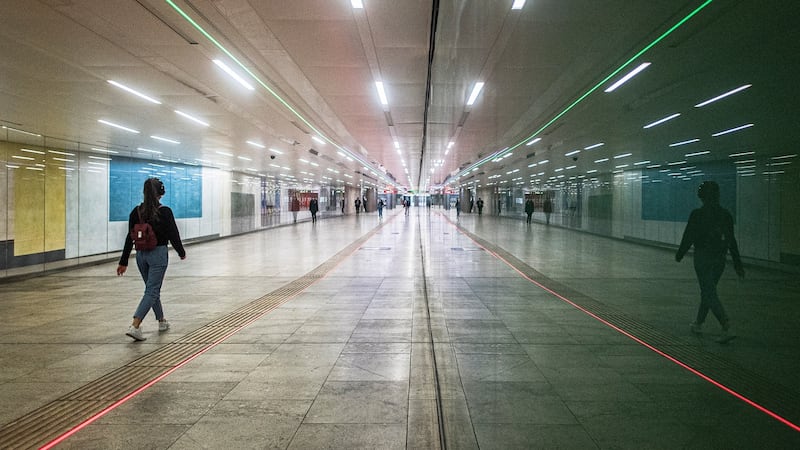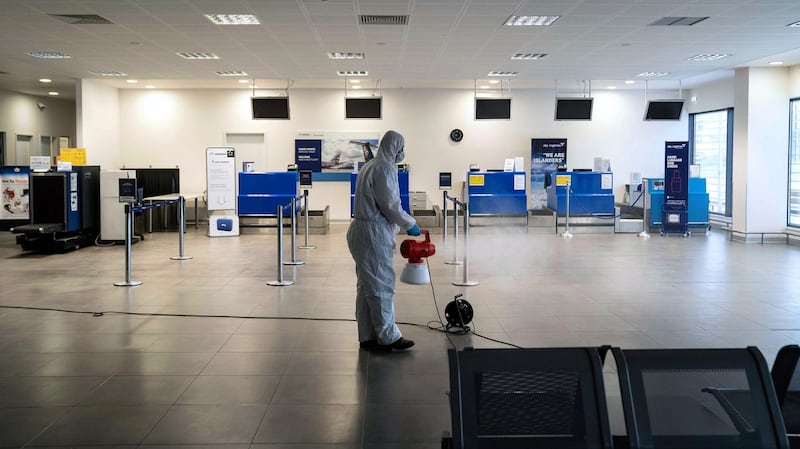The coronavirus pandemic is leading to significant economic costs. Attributing these costs to the shutdown is the wrong way of thinking about it - the restrictions are needed to control the pandemic. And succeeding in doing this is the vital step to economic recovery as well.
So as we consider the possible exit strategy from the restrictions in Ireland, the challenge is trying to work out how to gradually reopen the economy, while minimising the risk.
Emerging research on the subject highlights the essential link between economic and healthcare policies – to protect people the restrictions will lift only very gradually and need to be accompanied by the wide availability of testing and contact tracing. And the continuation of social distancing .
If people are going back into the workforce in greater numbers, this is the essential strategy to protect them, find out who is sick and ensure their contacts go quickly into isolation .
Here are the key points in this decision:
1. Timing the move
This is obviously tricky and relies on a public health assessment that the peak is past and new cases at a low level. Beyond that, we have seen in parts of China and Singapore the reimposition of measures that had been lifted. A second wave of infections remains a serious risk.
Nonetheless, EU countries who feel they have the virus under some kind of control – Denmark, Austria, and the Czech Republi , for example – are gingerly planning the first steps to reopening.
Denmark, where shops have generally remained open, is to reopen schools and kindergartens. Austria is planning to start reopening some non-food retailers on a phased basis as is the Czech Republic.
No-one is planning to restart major gatherings before July or August at the earliest, however, and the future of tourism and of travel remains a big question. The road back will be long and gradual.
In Ireland, the timing of the start of easing of restrictions remains unclear and will be determined by the health data.
A phased strategy is inevitable.
Business sources believe that construction sites and non-essential manufacturing may be the first to reopen. Non-food retail stores could also be in the first wave, or soon after.
This would essentially roll back the final wave of closures.
It would be up to the public health experts to advise the Government on whether restrictions on public movement would be adjusted at the same time. Again the moves elsewhere in the EU look set to be gradual here, with continued restrictions on any kind of large gatherings.
The other big questions will be whether to reopen schools and universities. A report by the influential IFO Institute in Germany suggested this could happen early, given that younger people are less likely to fall seriously ill.
However, there are difficult issues here, not least the risk that some younger people might get ill, or that they might spread the virus to their families or wider in the community.
The Danish government is getting flak here and Austria is to keep schools closed, probably until September.

From the point of view of the public finances, this partial reopening would remove a large chunk of people from income supports.
Reopening sooner rather than later also lessens the risks that some companies will not be able to reopen at all – and will get some more cash flowing through the economy.
There is, of course, an “if” here. If the restrictions are raised too soon and the virus starts to spread again quickly, then the risk is of having to close things down again.
This would be a big setback to the public health programme and be economically disruptive – for both health and economic reasons we need the virus to be under control.
So policy is likely to be biased to taking this slowly. A study by economists at MIT and the US Fed found that cities which had earlier and tighter restrictions during the 1918 Spanish Flu had better health and economic outcomes in the the longer term.
2. Managing the reopening
International studies – such as the one by the IFO, or work by the Tony Blair Institute for Global Change in the UK – underline that easing restrictions without accompanying health policies would run way too high a risk of re-igniting the virus.
There is no “ right” answer here – all we have to go on so far is the gradual reopening in parts of the Far East.
However, there is general agreement that the availability of widespread testing and associated contact tracing is vital.
So while ramping up testing in Ireland is important to control the virus, it is also essential if we are to successfully start reopening parts of the economy again. We would be moving from a position where the rules are controlling the movement of a large part of the population to one where we are trying to control a much smaller part - those who are sick and their contacts.
A quick availability of swab tests and results and quick contact tracing and isolation is therefore vital.
The phone App which is being developed to inform people when they were in contact with someone who has tested positive is part of this – how this will work and how information will be stored may well be controversial.
The IFO study says there are privacy and functional questions here which need to be worked through, but the more traditional route to contact tracing will remain vital in any case: public health authorities talking to those affected and alerting their contacts.
The studies also raise the possibility of antibody testing – to see who has been exposed to the virus and may thus be immune.
A reliable method does not yet appear to be available and questions remain about the level of confidence with which people may be judged immune.
In time though this could become an important tool.
With or without this, some people may be encouraged, or told, to remain out of the workforce for a larger period, including the over-70s or those with underlying health conditions.
This may be difficult if the choice for someone is to return to work, or remain on the €350 Covid-19 weekly payment.

3. Other approaches to reopening
The studies look at a range of other tactics and approaches which may help in the gradual reopening . Some may work in Ireland, others perhaps not.
The Imperial College in London has suggested "adaptive triggering". This would involve tightening restrictions when ICU capacity starts to fill up and loosening them as pressure on the health system eased.
This could continue until a vaccine was available.
Most of the studies concluded this would be disruptive for businesses and for society – though accepting that in practice the option of reimposing some restrictions would have to be held in reserve.
The IFO study also suggested the possibility of geographical factors coming into play, with restrictions easing more quickly in regions with lower infections or more bed capacity.
Whether Ireland is big enough to consider such an approach is not clear?
Demographic factors – keeping older or vulnerable people out of work longer is also raised as an option.Those who are judged immune due to having had the virus could be another group to return, but as outlined above a reliable test is not generally available.
Asking people to wear masks is also suggested in some studies ,but as we know views are divided on this.
4. Reopening - the responsibility on employers/companies
As workplace start to reopen, (and they will, eventually) significant responsibility will fall on employers. Social distancing will need to be a factor in all workplaces – and this may be difficult on some construction sites or less-automated production lines.
There may be some difficult employee issues – for example in relation to who can and who cannot return to work in the first wave – both for economic and health reasons. Will you be asked to return home if you have an elevated temperature?
Public-facing businesses will also be expected to control numbers and queues to ensure social distancing, as food stores are doing now.
Rigorous cleaning will be needed in all workplaces and in some cases protective clothing may be needed for those undertaking this.
Meanwhile, some sectors will face uncertainty in terms of when they will be allowed to reopen, notably pubs and other places where people gather indoor in large groups - clubs, bingo halls and so on.
The IFO report argues that in its view, in a German context, while it is for Government to lay down standards, businesses must apply them
The bottom line
The bottom line is reopening will be difficult and tricky and a lot needs to be done to keep people as safe as possible.
In theory we could just decide to keep a large part of the economy closed as it is now until a vaccine is found and is available.
However, the economic and social costs would be enormous.
So for public health and economic reasons the lifting of restrictions will be slow and gradual and having accompanying policies in place will be absolutely vital.












